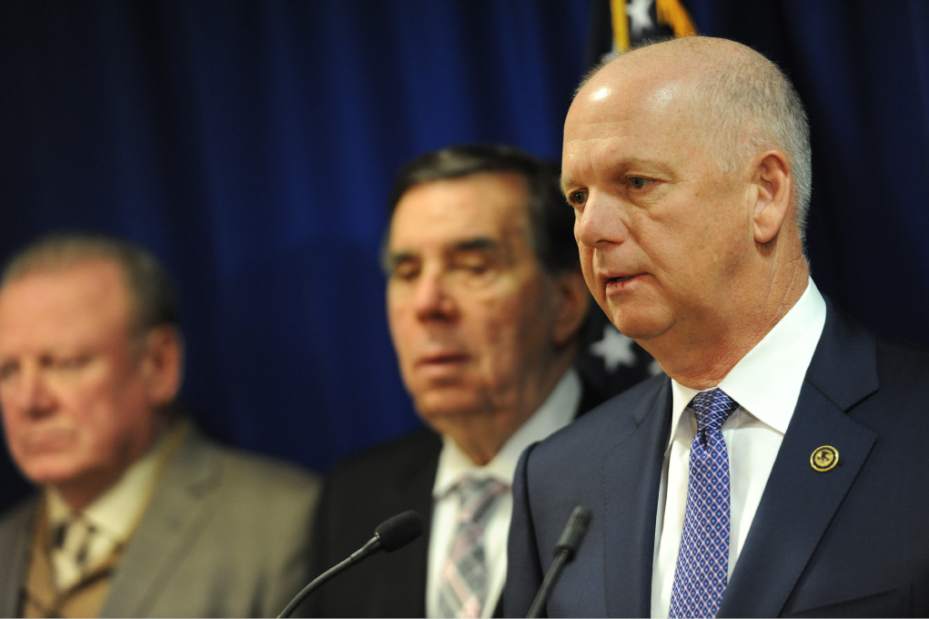U.S. attorney in Pittsburgh calls heroin surge public health crisis
(Part four of a six-part series on the effects of heroin on the Mid-Mon Valley.)
David Hickton contends the effort to stem heroin trafficking and addiction is not a losing cause.
He sees it as cumulative law enforcement problem.
“It's not a war, it's a public health crisis,” the Pittsburgh-based U.S. attorney said.
In his 2014 report, “U.S. Attorney's Working Group on Drug Overdose and Addiction: Prevention, Intervention, Treatment and Recovery,” Hickton wrote: “We cannot prosecute or incarcerate our way out of this problem. To reduce overdose deaths, we need to recognize that addiction is an illness that can be treated, and to do so we must eliminate the stigma surrounding substance abuse and seeking treatment.”
“I cannot say it better than we said in the report,” Hickton said in a recent interview. “We have to be as vigilant about preventing the problem as prosecuting it.”
Heroin is most prevalent in the New England, Great Lakes and Mid-Atlantic regions. Methamphetamine is the leading drug in much of United States. But in western Pennsylvania, it has been surpassed by heroin.
“We've gotten to the point heroin and synthetic heroin opiates, in general, are so prevalent in society and so highly addictive that we now have an epidemic,” Hickton said. “It's the number one drug problem we're handling here.”
Heroin is part of a more serious opiate problem here that authorities only began to fully grasp in recent years.
“Because pills are prescribed in such large numbers, and there are people who take pills and not heroin, we were blinded into thinking there was no connect,” Hickton said of prescription painkillers.
In Allegheny County, 299 overdoses occurred last year. Overdoses have quadrupled in Washington and Westmoreland counties over the past three years.
By 2009, drug overdoses had eclipsed car accidents as the leading cause of accidental deaths in the region.
Hickton pointed to the 2014 Drug Enforcement Agency's National Drug Threat Assessment Summary. It concluded that heroin abuse and availability are increasing, particularly in the eastern United States. The summary cited a 37 percent increase in people using heroin for the first time from 2008 through 2012.
The report said many municipalities, especially in the Northeast and Midwest, are reporting increasing heroin overdose deaths.
The overdoses are in part linked to heroin tainted with fentanyl or fentanyl being sold as heroin. Fentanyl, a synthetic, short-acting narcotic, is much stronger than heroin and can cause even experienced abusers to overdose.
Hickton serves as chairman of the National Heroin Task Force, which was formed because of the rapid increase in overdose deaths. He said it is seeking “the good solutions” to the heroin problem.
The increase in overdose deaths led to the development of Narcan – also known as naloxone – a drug that can reverse the effects of opioid drugs such as heroin in overdose cases.
“The call to use Narcan came out of our work last year and is being used by police, EMTs and treatment centers,” Hickton said. “We have a standing order in Pennsylvania for the use of Narcan.”
A standing order is a written document containing rules, policies, procedures, regulations and orders for patient care in clinical situations.
“It should be as available as defibrillators,” Hickton said of Narcan.
Automated external defibrillators are small, portable electronic devices designed to provide electric shocks to re-establish heart rhythm in cardiac arrest victims.
Hickton said society must differentiate between those who are heroin traffickers and addicts who are truly sick.
“We have to make people understand that addiction is an illness, and there is a stigma associated with this illness,” Hickton said.
People who become addicted because of pain related to sports or orthopedic injuries are often embarrassed to get help, so the problem worsens, experts say.
Why is it worse here?
“I don't think we fully understand that,” Hickton said of the rise of heroin in the region. “The answer to that question is important in solving the demand.”
Part of the cause might be related to “the flow of highways because they are arteries for illegal drug shipments,” Hickton said.
That's why his office has special relationships with district attorneys such as Gene Vittone in Washington County, where interstates 70 and 79 intersect.
“What we think we understand about illegal drugs is the highways are the byways of illegal drugs,” Hickton said. “Heroin seems to follow where highways are and be more prevalent in the urban parts of the country.”
Hickton is working on the demand side of the problem through education, outreach, physical training and community awareness. He said it is cheaper to treat people than incarcerate them, adding that treatment is more effective.
Asked if the heroin problem will get worse before it gets better, Hickton said, “I can't forecast that. I hope not.”
“I don't accept that it is futile,” Hickton said of the war on heroin. “We can reduce the supply of illegal drugs, reduce the people who are addicted and I live in the world of can do.”
Chris Buckley is a staff writer for Trib Total Media. He can be reached at cbuckley@tribweb.com or 724-684-2642.

